Abstract
To determine the quantitative relationship of urinary hydroxyproline peptide excretion to collagen breakdown, known quantities of radioactive hydroxyproline peptides were administered to unlabeled animals and excertion of radioactivity in respiratory carbon dioxide, urine, and feces was measured. The major routes of excretion of collagen peptide metabolites were respiratory carbon dioxide (75%) and urine, as hydroxyproline-containing peptides (25%).
Since the predominant urine hydroxyproline peptide linkage is proly-hydroxyproline, L-prolyl-L-hydroxyproline-3H was administered to unlabeled animals. Greater than 80% of the administered dipeptide was excreted in urine, suggesting that this peptide linkage is not hydrolyzed to a significant extent in vivo.
These data suggest that urinary hydroxyproline excretion is a “fairly” sensitive indicator of collagen breakdown and can be used at the clinical level to quantitate changes in collagen breakdown.
Full text
PDF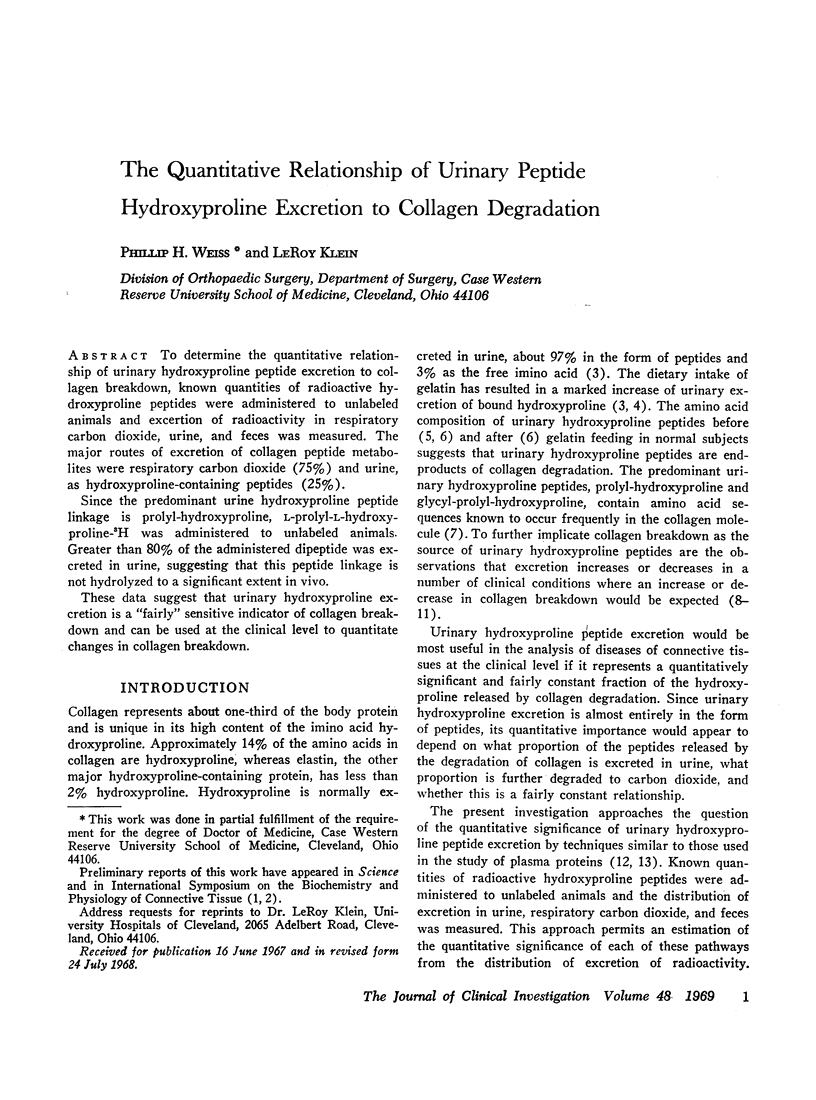
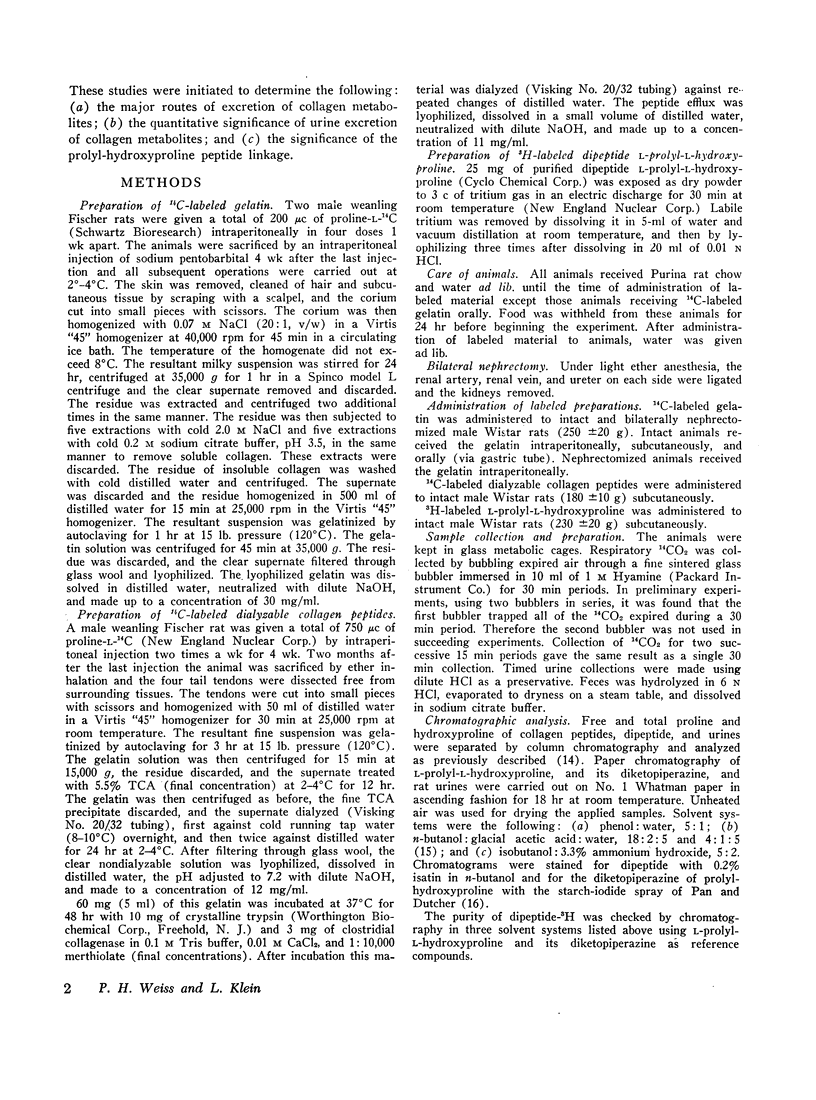

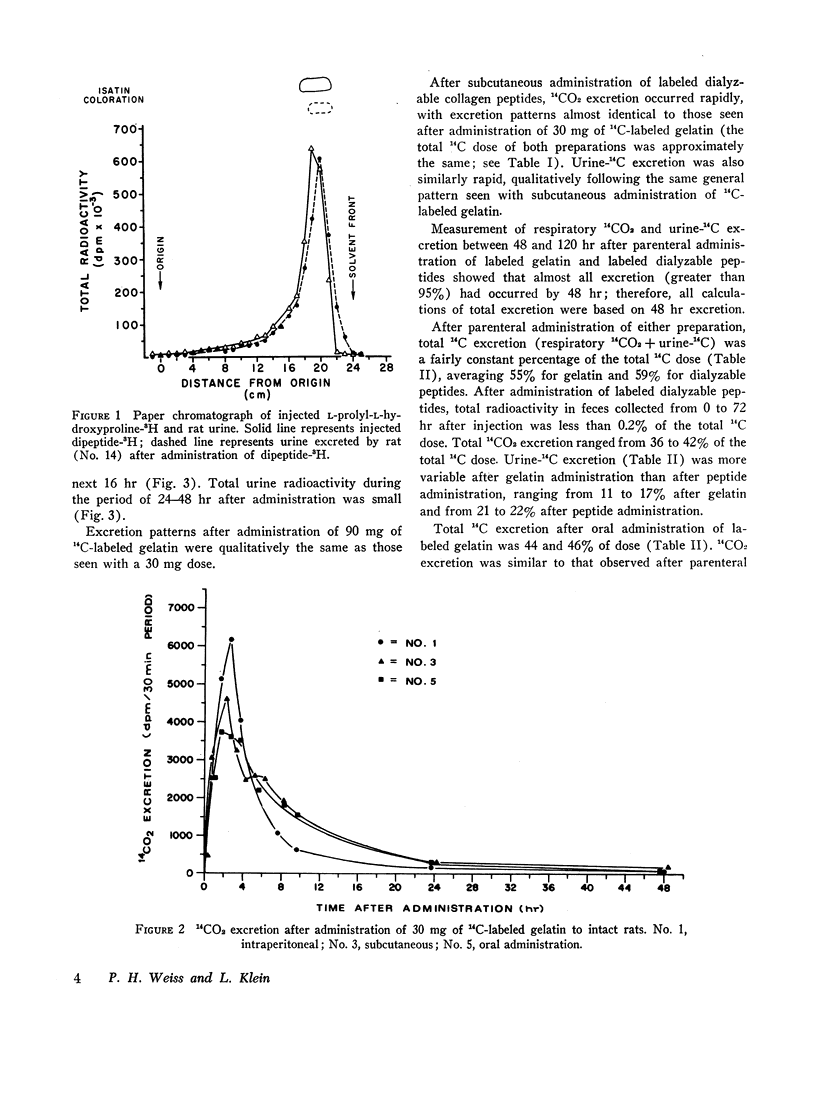
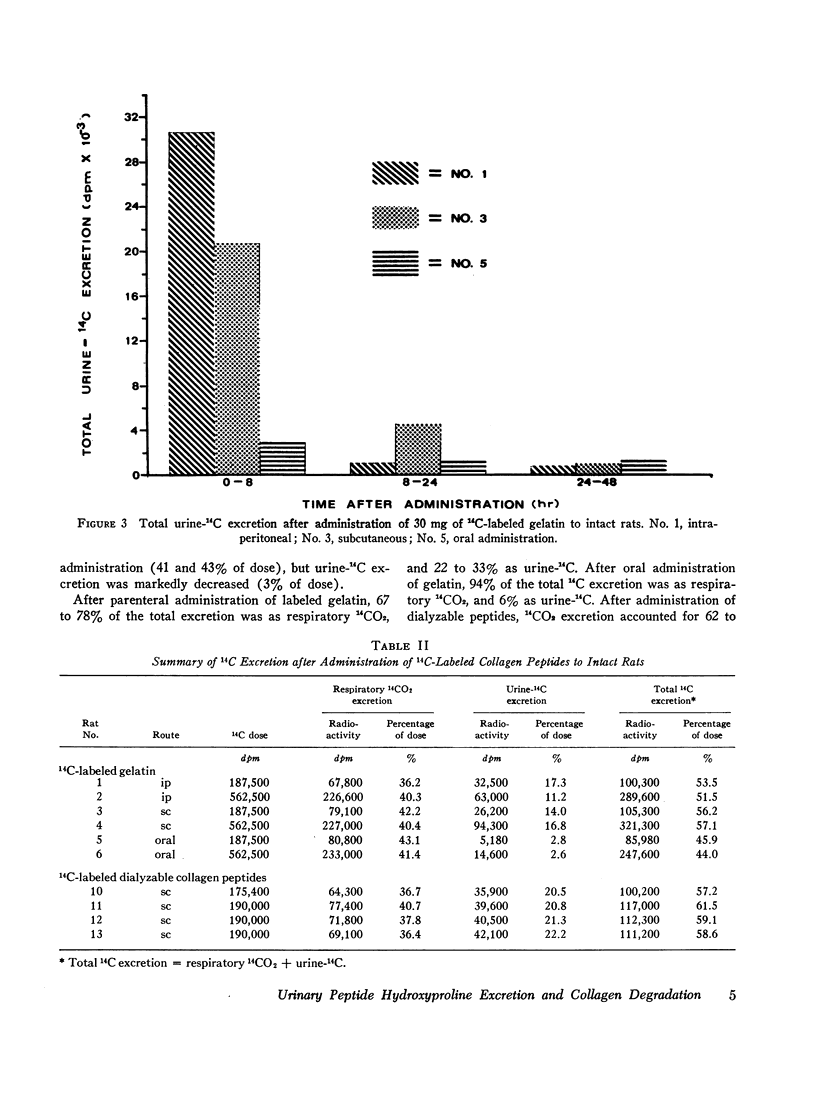
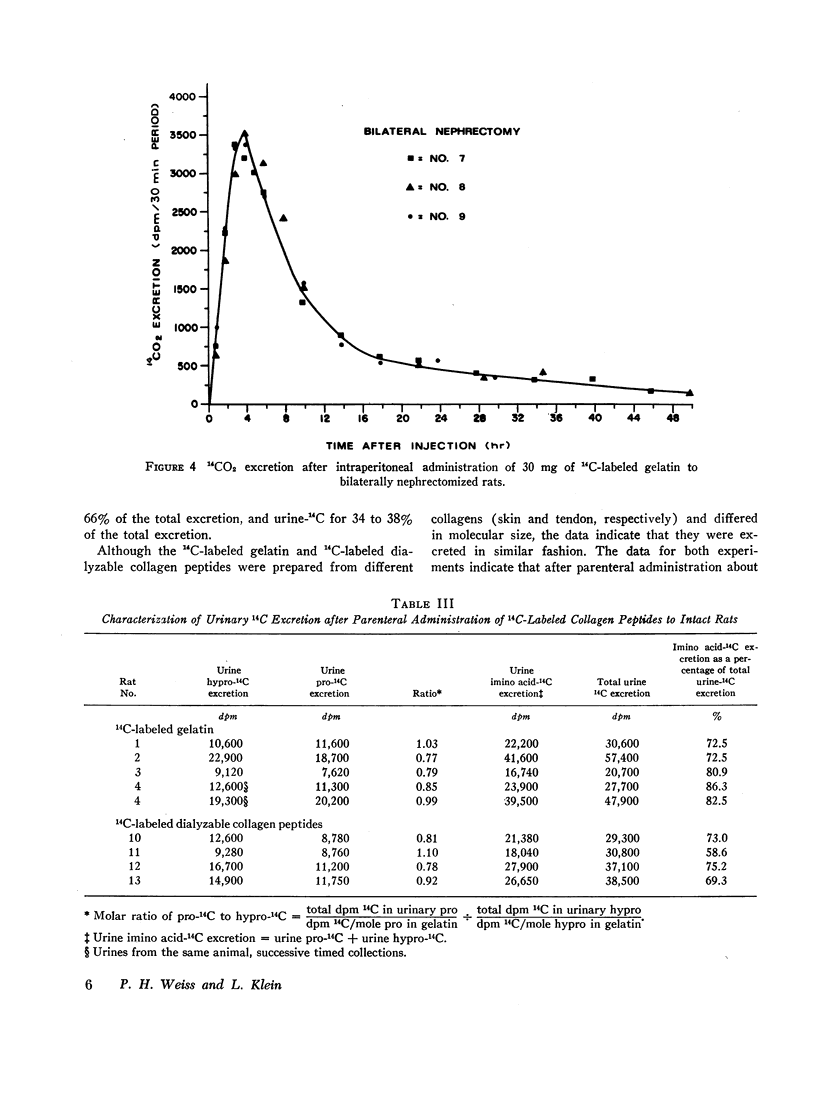

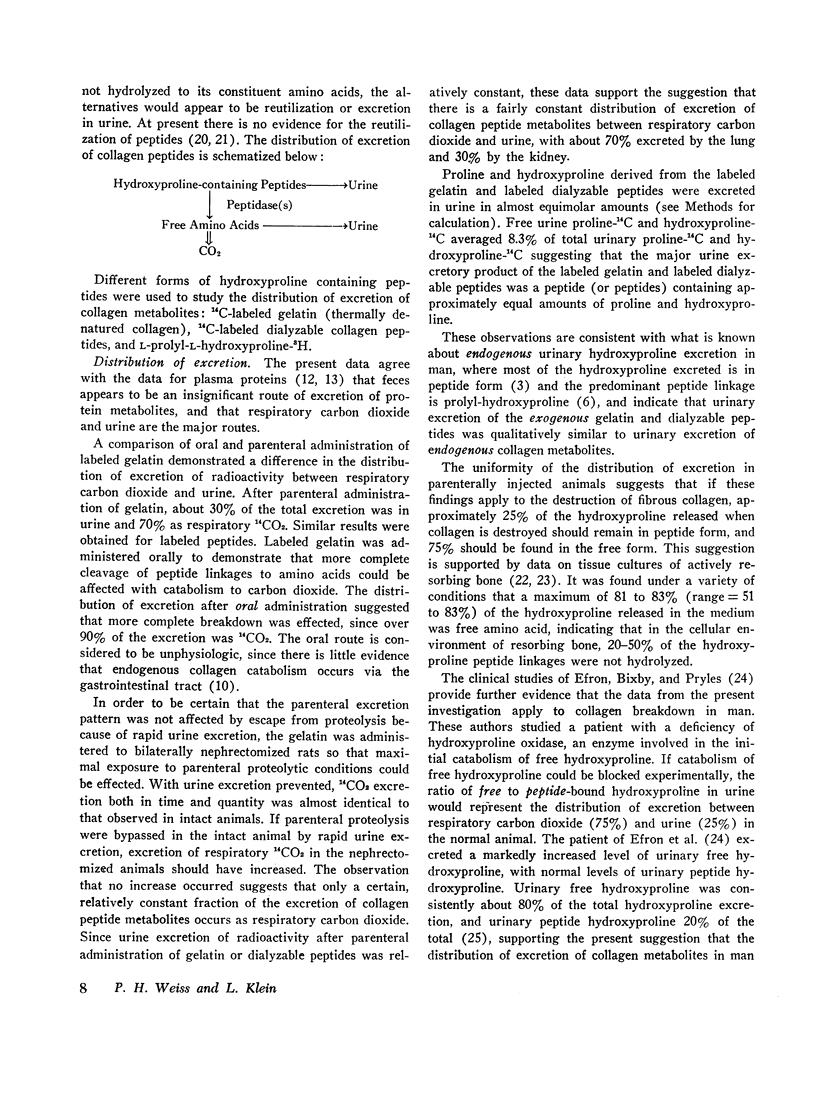
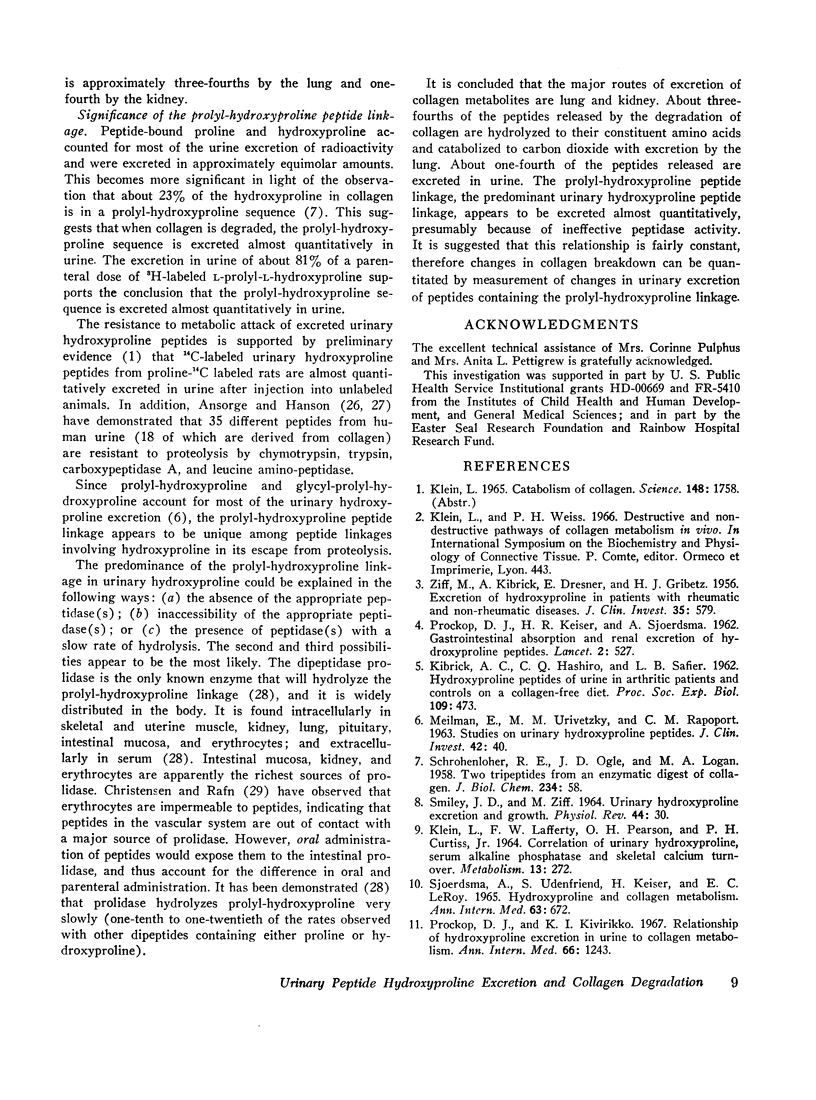
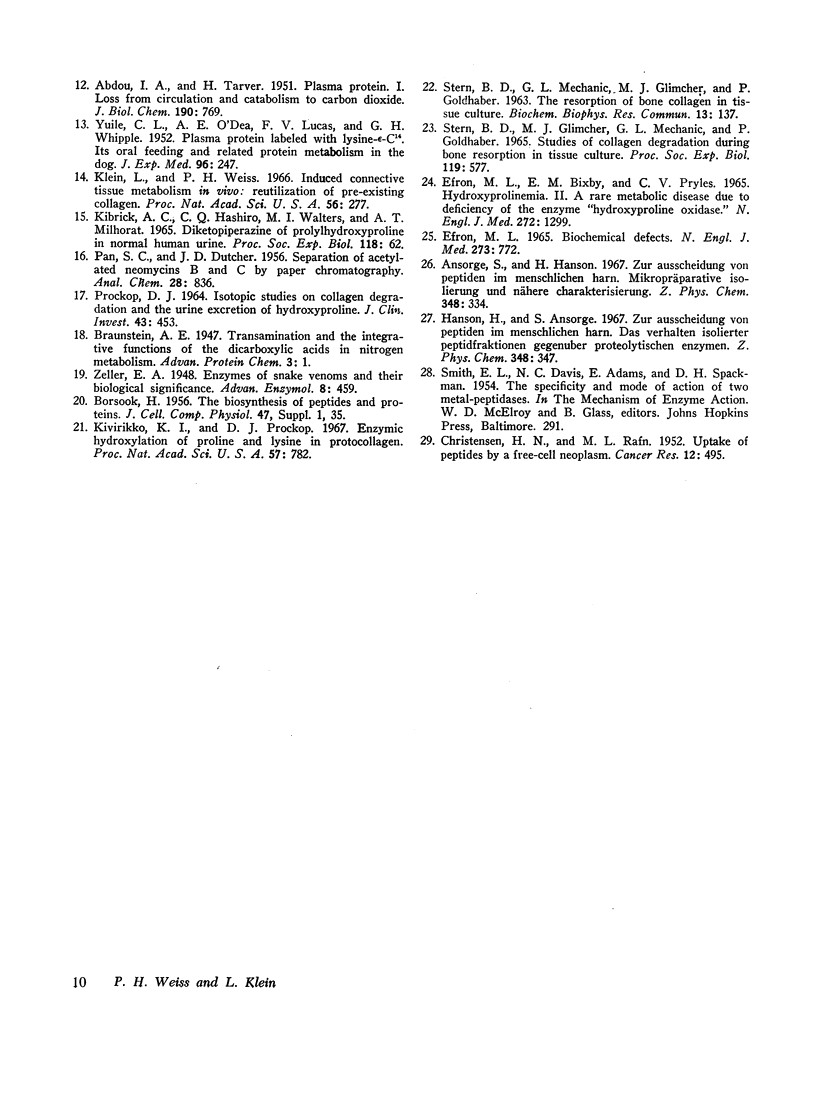
Selected References
These references are in PubMed. This may not be the complete list of references from this article.
- ABDOU I. A., TARVER H. Plasma protein. I. Loss from circulation and catabolism to carbon dioxide. J Biol Chem. 1951 Jun;190(2):769–780. [PubMed] [Google Scholar]
- Ansorge S., Hanson H. Zur Ausscheidung von Peptiden im menschlichen Harn. Mikropräparative Isolierung und nähere Charakterisierung. Hoppe Seylers Z Physiol Chem. 1967 Mar;348(3):334–346. [PubMed] [Google Scholar]
- Bensusan H. B., Klein L. Catabolism of Collagen. Science. 1965 Jun 25;148(3678):1758–1768. doi: 10.1126/science.148.3678.1758. [DOI] [PubMed] [Google Scholar]
- CHRISTENSEN H. N., RAFN M. L. Uptake of peptides by a free-cell neoplasm. Cancer Res. 1952 Jul;12(7):495–497. [PubMed] [Google Scholar]
- EFRON M. L., BIXBY E. M., PRYLES C. V. HYDROXYPROLINEMIA. II. A RARE METABOLIC DISEASE DUE TO A DEFICIENCY OF THE ENZYME "HYDROXYPROLINE OXIDASE". N Engl J Med. 1965 Jun 24;272:1299–1309. doi: 10.1056/NEJM196506242722501. [DOI] [PubMed] [Google Scholar]
- Hanson H., Ansorge S. Zur Ausscheidung von Peptiden im menschlichen Harn. Das Verhalten isolierter Peptidfraktionen gegenüber proteolytischen Enzymen. Hoppe Seylers Z Physiol Chem. 1967 Mar;348(3):347–351. [PubMed] [Google Scholar]
- Hydroxyproline and collagen metabolism. Clinical implications. Ann Intern Med. 1965 Oct;63(4):672–694. [PubMed] [Google Scholar]
- KIBRICK A. C., HASHIRO C. Q., SAFIER L. B. Hydroxyproline peptides of urine in arthritic patients and controls on a collagen-free diet. Proc Soc Exp Biol Med. 1962 Mar;109:473–478. doi: 10.3181/00379727-109-27240. [DOI] [PubMed] [Google Scholar]
- KIBRICK A. C., HASHIRO C. Q., WALTERS M. I., MILHORAT A. T. DIKETOPIPERAZINE OF PROLYLHYDROXYPROLINE IN NORMAL HUMAN URINE. Proc Soc Exp Biol Med. 1965 Jan;118:62–64. doi: 10.3181/00379727-118-29756. [DOI] [PubMed] [Google Scholar]
- KLEIN L., LAFFERTY F. W., PEARSON O. H., CURTISS P. H., Jr CORRELATION OF URINARY HYDROXYPROLINE, SERUM ALKALINE PHOSPHATASE AND SKELETAL CALCIUM TURNOVER. Metabolism. 1964 Mar;13:272–284. doi: 10.1016/0026-0495(64)90106-4. [DOI] [PubMed] [Google Scholar]
- Kivirikko K. I., Prockop D. J. Enzymatic hydroxylation of proline and lysine in protocollagen. Proc Natl Acad Sci U S A. 1967 Mar;57(3):782–789. doi: 10.1073/pnas.57.3.782. [DOI] [PMC free article] [PubMed] [Google Scholar]
- Klein L. R., Weiss P. H. Induced connective tissue metabolism in vivo: reutilization of pre-existing collagen. Proc Natl Acad Sci U S A. 1966 Jul;56(1):277–284. doi: 10.1073/pnas.56.1.277. [DOI] [PMC free article] [PubMed] [Google Scholar]
- MEILMAN E., URIVETZKY M. M., RAPOPORT C. M. Urinary hydroxyproline peptides. J Clin Invest. 1963 Jan;42:40–50. doi: 10.1172/JCI104694. [DOI] [PMC free article] [PubMed] [Google Scholar]
- PROCKOP D. J. ISOTOPIC STUDIES ON COLLAGEN DEGRADATION AND THE URINE EXCRETION OF HYDROXYPROLINE. J Clin Invest. 1964 Mar;43:453–460. doi: 10.1172/JCI104930. [DOI] [PMC free article] [PubMed] [Google Scholar]
- PROCKOP D. J., KEISER H. R., SJOERDSMA A. Gastrointestinal absorption and renal excretion of hydroxyproline peptides. Lancet. 1962 Sep 15;2(7255):527–528. doi: 10.1016/s0140-6736(62)90400-2. [DOI] [PubMed] [Google Scholar]
- SCHROHENLOHER R. E., OGLE J. D., LOGAN M. A. Two tripeptides from an enzymatic digest of collagen. J Biol Chem. 1959 Jan;234(1):58–61. [PubMed] [Google Scholar]
- SMILEY J. D., ZIFF M. URINARY HYDROXYPROLINE EXCRETION AND GROWTH. Physiol Rev. 1964 Jan;44:30–44. doi: 10.1152/physrev.1964.44.1.30. [DOI] [PubMed] [Google Scholar]
- STERN B. D., GLIMCHER M. J., MECHANIC G. L., GOLDHABER P. STUDIES OF COLLAGEN DEGRADATION DURING BONE RESORPTION IN TISSUE CULTURE. Proc Soc Exp Biol Med. 1965 Jun;119:577–583. doi: 10.3181/00379727-119-30243. [DOI] [PubMed] [Google Scholar]
- YUILE C. L., O'DEA A. E., LUCAS F. V., WHIPPLE G. H. Plasma protein labeled with lysine-epsilon-C14; its oral feeding and related protein metabolism in the dog. J Exp Med. 1952 Sep;96(3):247–254. doi: 10.1084/jem.96.3.247. [DOI] [PMC free article] [PubMed] [Google Scholar]
- ZIFF M., KIBRICK A., DRESNER E., GRIBETZ H. J. Excretion of hydroxyproline in patients with rheumatic and non-rheumatic diseases. J Clin Invest. 1956 Jun;35(6):579–587. doi: 10.1172/JCI103311. [DOI] [PMC free article] [PubMed] [Google Scholar]


